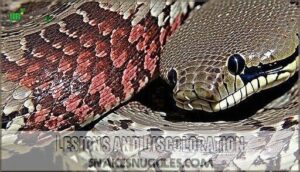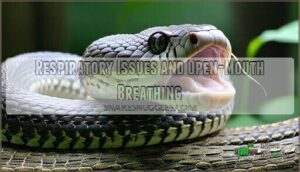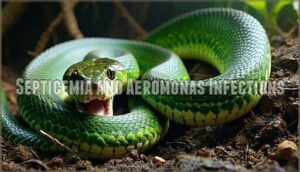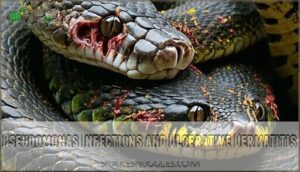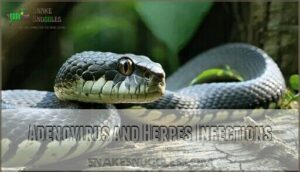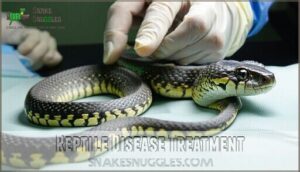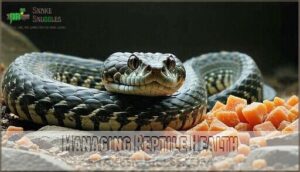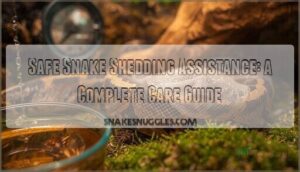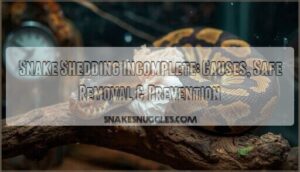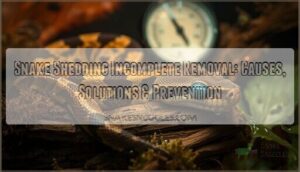This site is supported by our readers. We may earn a commission, at no cost to you, if you purchase through links.
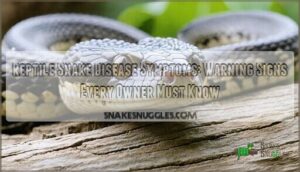 You’ll spot reptile snake disease symptoms through several key warning signs that shouldn’t be ignored. Watch for lethargy, loss of appetite, and difficulty breathing – these often signal serious health issues.
You’ll spot reptile snake disease symptoms through several key warning signs that shouldn’t be ignored. Watch for lethargy, loss of appetite, and difficulty breathing – these often signal serious health issues.
Skin problems like lesions, discoloration, or trouble shedding are red flags, as are mites crawling on your snake’s body. Respiratory distress shows up as open-mouth breathing or wheezing sounds.
Changes in behavior, excessive salivation, or unusual discharge from eyes or mouth also indicate illness. Some snakes develop convulsions or lose coordination when severely ill.
The tricky part? Many symptoms overlap between different diseases, making professional diagnosis essential for proper treatment and your pet’s recovery. This is crucial because it ensures the right course of action is taken to address the specific health issues.
Table Of Contents
- Key Takeaways
- Reptile Disease Symptoms
- Snake Infection Signs
- Common Reptile Diseases
- Reptile Disease Treatment
- Managing Reptile Health
- Frequently Asked Questions (FAQs)
- How to tell if a snake has an infection?
- What is the most common disease in reptiles?
- What are the symptoms of inclusion body disease in reptiles?
- What are the symptoms of adenovirus in reptiles?
- How long do snake diseases take to develop?
- Can snakes recover from viral infections naturally?
- What temperature prevents most snake respiratory infections?
- Are juvenile snakes more susceptible to diseases?
- Which snake species get sick most frequently?
- Conclusion
Key Takeaways
- Watch for early warning signs – You’ll catch problems sooner by monitoring your snake’s appetite, breathing patterns, and activity levels, since lethargy and loss of appetite often appear before more serious symptoms develop.
- Don’t ignore skin and respiratory issues – You should act immediately if you notice open-mouth breathing, wheezing, skin lesions, discoloration, or difficulty shedding, as these symptoms indicate infections that can quickly become life-threatening.
- Multiple symptoms require professional diagnosis – You can’t rely on self-diagnosis since many snake diseases share similar symptoms, making veterinary expertise essential for proper identification and treatment.
- Prevention beats treatment every time – You’ll avoid most health issues by maintaining proper temperature gradients, humidity levels, clean enclosures, and regular veterinary checkups rather than waiting for symptoms to appear.
Reptile Disease Symptoms
You’ll notice several early warning signs when your reptile develops health problems, from subtle appetite changes to obvious breathing difficulties.
Recognizing these symptoms quickly can mean the difference between a simple treatment and a life-threatening emergency for your scaly companion.
Appetite Changes and Lethargy
One significant red flag you’ll notice is when your snake suddenly loses interest in food or becomes unusually inactive.
Anorexia causes in reptiles often signal underlying health issues, while lethargy indicators include reduced movement and poor response to stimuli.
These behavioral shifts typically accompany energy level drops, making feeding problems more apparent.
Monitor these reptile disease symptoms closely, as appetite changes and lethargy frequently precede serious conditions requiring immediate veterinary attention.
Abnormal Breathing and Skin Issues
Watch for respiratory distress signals like wheezing sounds, open-mouth breathing, and nasal discharge – these snake disease symptoms often indicate serious respiratory infections.
Skin issues present as scale rot, lesions, or discolored patches on your reptile’s body.
Abnormal breathing patterns combined with skin problems usually signal environmental stress or bacterial infections requiring immediate veterinary attention.
Viral and Fungal Infections
Beyond breathing problems and skin changes, viral infections and fungal diseases present distinct warning signs you can’t ignore.
Viral transmission often causes sudden weakness, while fungal dermatitis creates flaky, peeling skin patches.
These conditions compromise your snake’s immune system, making recovery challenging without proper intervention.
Key indicators of viral and fungal infections:
- Snake viral disease symptoms – Weight loss, respiratory distress, and neurological signs like "star gazing" behavior
- Fungal diseases manifestations – White, crusty patches on scales or systemic mycosis affecting internal organs
- Immunity suppression effects – Increased susceptibility to secondary infections and slower healing
- Snake fungal disease progression – Lesions spreading across the body with thickened, discolored scales
- Antiviral therapies limitations – Most viral infections require supportive care since specific treatments remain limited
Parasites and Bacterial Infections
Parasites and bacterial infections present distinct warning signs you’ll need to recognize quickly.
Internal parasites cause diarrhea, weight loss, and particularly foul-smelling feces, while external parasites like mites appear as tiny moving specks causing intense itching.
Bacterial infections from poor hygiene create skin lesions, breathing problems, and lethargy.
Early detection prevents antibiotic resistance and serious complications.
Snake Infection Signs
When you’re caring for snakes, recognizing infection signs early can mean the difference between a quick recovery and a serious health crisis.
Snake infections often start with subtle changes that many owners miss, but knowing what to watch for helps you catch problems before they become life-threatening.
Lesions and Discoloration
Your snake’s skin tells a story, and abnormal lesions or discoloration are red flags you can’t ignore.
Healthy scales should appear smooth and shiny, while reptile skin infections create visible warning signs that demand immediate attention.
- Scale Abnormalities: Look for raised, rough, or irregularly shaped scales that feel different from normal skin texture
- Blister Appearance: Watch for fluid-filled bumps or pustules that signal bacterial infections beneath the surface
- Color Changes: Notice darkening, reddening, or unusual patches that contrast sharply with your snake’s natural coloration
Ulcer development and tissue necrosis represent advanced stages of reptile disease symptoms, often appearing as open wounds or blackened areas where healthy tissue has died.
Difficulty Shedding and Mite Infestations
Shedding problems create perfect conditions for opportunistic infections. When your snake can’t properly shed its skin, retained pieces become breeding grounds for bacteria and parasites.
| Problem | Signs | Causes | Action |
|---|---|---|---|
| Dysecdysis | Retained eye caps, ragged skin | Low humidity, poor nutrition | Increase humidity, vet visit |
| Mite Infestation | Tiny red/black specks, excessive soaking | Poor quarantine, contaminated substrate | Isolate snake, treat environment |
Snake shedding problems often coincide with mite identification challenges. These skin parasites exploit weakened areas where old skin remains attached. Proper shedding environment maintenance prevents both dysecdysis causes and infestation prevention failures, reducing reptile skin infection risks.
Respiratory Issues and Open-Mouth Breathing
Respiratory problems can quickly become life-threatening emergencies.
Watch for abnormal breathing patterns, wheezing sounds, or open-mouth breathing—clear Pneumonia Signs requiring immediate attention.
High Humidity Levels around 60-80% help prevent respiratory distress, while poor ventilation increases Aspiration Risk.
Snake respiratory illness often causes visible mucus discharge and labored breathing.
Nebulization Therapy may be prescribed by veterinarians, but Secondary Infections frequently complicate recovery without prompt treatment.
Loss of Appetite and Excessive Salivation
When your snake turns its nose up at food, you’re witnessing one of reptile lethargy signs that demands attention.
Snake anorexia causes range from underlying conditions like infectious stomatitis to environmental stress. Excessive salivation often accompanies loss of appetite, creating a concerning combination.
During oral examination, you’ll notice thick mucus and foul odors. Ptyalism effects include dehydration, making hydration importance critical.
Regular check-ups can help with early diagnosis. Snake symptoms like these indicate snake diseases symptoms requiring immediate veterinary care for proper diagnosis and treatment.
Common Reptile Diseases
Understanding common reptile diseases helps you protect your scaly companions from serious health threats.
These conditions range from bacterial infections like septicemia to viral diseases that can devastate entire collections if left unchecked, highlighting the importance of understanding viral diseases.
Septicemia and Aeromonas Infections
Bacterial infections like septicemia can turn your snake’s world upside down fast.
Bacterial infections spread fast – catching them early saves lives.
Septicemia causes include poor husbandry impacts, stress, and wounds that let Aeromonas bacteria enter the bloodstream.
You’ll notice Aeromonas symptoms like lethargy, red belly scales, and open-mouth breathing.
These bacterial infections compromise reptile immunity, making treatment options essential for survival.
Maintaining a clean habitat can reduce the risk of septicemia development.
Pseudomonas Infections and Ulcerative Dermatitis
Moisture-loving bacteria thrive when husbandry fails, making ulcerative dermatitis a common threat you’ll face as a reptile owner.
Poor hygiene importance creates perfect conditions for Pseudomonas symptoms to emerge rapidly.
- Red, swollen skin with fluid-filled blisters
- Yellow, green, or black discoloration around lesions
- Open sores that may bleed or discharge pus
- Lethargy and loss of appetite in affected reptiles
Ulcerative causes stem from dirty substrates and excessive humidity, allowing bacterial infections to penetrate damaged skin.
Reptiles can also develop septicemic cutaneous ulcerative disease due to bacterial infections.
Without proper treatment options, these reptile bacterial infections can progress to life-threatening septicemia.
Infection prevention starts with maintaining clean, dry environments and addressing wounds immediately.
Adenovirus and Herpes Infections
Viral infections like adenoviruses and herpesviruses hit reptiles hard, causing systemic damage that spreads quickly through collections.
You’ll notice Adenovirus Symptoms including severe lethargy, regurgitation, and stunted growth, while Herpes Transmission leads to mouth rot and conjunctivitis.
Both snake diseases can cause sudden death in healthy-appearing animals, making early detection essential for your collection’s survival.
Owners should also monitor for unusual breathing patterns, which can be a critical indicator of disease.
Inclusion Body Disease and Paramyxovirus
Two devastating viral infections pose serious threats to your snake’s health. Inclusion Body Disease (IBD) and paramyxovirus cause neurological symptoms that progress rapidly, making early detection essential for preventing collection-wide outbreaks.
Warning Signs You Can’t Ignore:
- IBD Diagnosis markers: "Stargazing" behavior, inability to right themselves, persistent anorexia, and chronic regurgitation in pythons and boas
- Paramyxo Symptoms progression: Open-mouth breathing, nasal discharge, head tremors, and eventual paralysis within weeks
- Viral Transmission routes: Direct contact, mite vectors, contaminated equipment, and asymptomatic carrier snakes spreading infection
- Prevention Strategies: Strict quarantine protocols, PCR testing, and immediate isolation of symptomatic animals
Neither condition responds to treatment. Supportive Therapies provide temporary comfort, but these snake inclusion body disease and paramyxovirus infections remain fatal. Quick identification of reptile diseases symptoms prevents devastating losses in your collection.
Reptile Disease Treatment
When your reptile shows signs of illness, quick action can mean the difference between recovery and serious complications.
Treatment options range from simple environmental adjustments to intensive veterinary care, depending on the severity and type of condition affecting your pet, which may require intensive veterinary care.
Antibiotic Therapy and Surgical Intervention
Severe bacterial infections require injectable antibiotics like enrofloxacin or ceftazidime, delivered carefully to avoid the renal portal system.
Surgical intervention becomes necessary for abscesses that won’t heal naturally.
You’ll need to complete the full antibiotic course post-surgery to prevent antibiotic resistance. Post-op care includes wound monitoring and pain management to guarantee proper recovery.
Supportive Care and Dietary Changes
Beyond medication, your reptile needs thorough supportive care and dietary changes to recover fully.
Proper fluid therapy prevents dehydration while nutritional support helps rebuild strength. You’ll need to monitor wound management closely and maintain dietary balance throughout treatment.
- Fluid therapy – Administer subcutaneous or oral fluids to combat dehydration from illness
- Assisted feeding – Use syringe feeding for reptiles refusing food during recovery
- Wound management – Clean and dress injuries daily to prevent secondary infections
- Nutritional support – Provide easily digestible foods rich in vitamins and minerals
- Environmental adjustments – Maintain ideal temperature and humidity for healing
Antifungal and Deworming Medications
When treating fungal infections, itraconazole offers 85% antifungal efficacy in dermatophyte cases, while topical terbinafine shows 70% resolution rates.
For parasites, fenbendazole targets nematodes at 50-100mg/kg dosages. However, deworming resistance emerges from overuse, and medication side-effects like hepatotoxicity affect 10-30% of treated snakes.
Consider itraconazole reptile products for effective treatment. Proper dosage calculation prevents complications, though preventative deworming without confirmed diagnosis isn’t recommended.
Environmental Improvements and Isolation
Creating a proper reptile quarantine setup isn’t just about isolation—it’s about replicating ideal conditions that promote healing.
You’ll need strict biosecurity measures, including separate equipment and handwashing protocols between enclosures.
Maintain precise temperature gradients and humidity control to support your reptile’s immune system.
Habitat enrichment reduces stress during recovery, while quarantine protocols prevent spreading reptile diseases to healthy animals in your collection.
Ensuring proper temperature gradient maintenance is also essential for effective thermoregulation and overall immune system support.
Managing Reptile Health
You can prevent most reptile diseases by staying on top of regular health monitoring and maintaining proper care standards.
The key lies in combining routine veterinary checkups with consistent hygiene practices, proper nutrition, and environmental control to catch problems early before they become serious.
Regular Veterinary Checkups and Monitoring
You’ll want to schedule health exams every six to twelve months for early detection of problems before they become serious.
During these visits, your vet will perform thorough physical examinations and may recommend fecal testing or blood work.
Between appointments, daily symptom observation helps you catch changes in behavior, appetite, or appearance.
Document any concerns and follow quarantine protocols when introducing new reptiles to prevent disease spread.
Proper Hygiene and Sanitation Techniques
Maintaining clean conditions prevents disease spread and keeps your snake healthy. Start with thorough hand hygiene before and after handling your reptile.
Weekly enclosure cleaning involves scrubbing surfaces with reptile-safe disinfectants for effective cage disinfection. Replace substrate regularly and manage waste disposal promptly.
Monitor water quality by changing bowls frequently, as stagnant water breeds harmful bacteria. These sanitation techniques create a clean habitat that reduces infection risks substantially.
Proper hygiene practices are essential to prevent the spread of Salmonella. Maintaining clean conditions is crucial for the well-being of your snake.
Nutrition and Environmental Control
Your snake’s health hinges on species-specific Dietary Requirements and precise environmental control.
Temperature Gradients between basking and cool zones, proper Humidity Levels, and adequate Lighting Needs create ideal conditions.
Quality reptile nutrition prevents deficiencies, while consistent reptile environment monitoring supports snake health.
Habitat Enrichment through hiding spots and climbing structures reduces stress, promoting overall reptile health.
To guarantee proper conditions, utilize a reptile environment setup for monitoring.
Preventing Zoonotic Diseases and Parasites
Your reptile’s health depends on proper disease prevention measures that protect both you and your pet.
Handwashing importance can’t be overstated – it reduces Salmonella transmission by over 60%.
Regular enclosure cleaning with disinfectants eliminates most bacteria within minutes.
Safe handling practices and parasite prevention through routine fecal exams catch issues early.
Effective strategies include regular parasite control for a healthy reptile.
Public awareness of reptile diseases helps owners recognize symptoms quickly, ensuring better snake health outcomes through proactive disease prevention.
Frequently Asked Questions (FAQs)
How to tell if a snake has an infection?
Your snake’s body becomes a walking billboard for trouble when infection strikes.
Watch for lethargy, breathing difficulties, skin discoloration, mouth discharge, appetite loss, or unusual behavior changes requiring immediate veterinary attention.
What is the most common disease in reptiles?
Respiratory infections top the list as reptiles’ most frequent health issue. You’ll notice excess mucus, wheezing, open-mouth breathing, and lethargy when your scaly friend can’t shake this common ailment.
What are the symptoms of inclusion body disease in reptiles?
Looking at Inclusion Body Disease (IBD), you’ll notice distinctive neurological symptoms in affected boas and pythons.
Your snake might exhibit "star gazing" behavior, inability to right themselves when flipped, progressive paralysis, and loss of coordination that gradually worsens over time, which can be described as a form of progressive deterioration.
What are the symptoms of adenovirus in reptiles?
Like troubleshooting a computer virus, you’ll notice adenovirus causes weight loss, respiratory distress, sudden weakness, and organ damage.
Your reptile may show lethargy, breathing difficulties, and systemic illness requiring immediate veterinary attention.
How long do snake diseases take to develop?
Snake diseases develop at varying speeds depending on the type.
Bacterial infections like septicemia can progress within days, while viral diseases may take weeks to months.
Parasitic infections often develop gradually over several weeks, and some conditions remain dormant until stress triggers symptoms.
Can snakes recover from viral infections naturally?
Viral infections challenge snakes’ immune systems, viral infections weaken their defenses, viral infections rarely resolve without help.
Most snakes can’t naturally overcome viral diseases like paramyxovirus or IBD.
You’ll need supportive veterinary care to help them survive, which is crucial for snakes with weakened defenses due to viral infections.
What temperature prevents most snake respiratory infections?
You’ll want to maintain temperatures between 75-85°F (24-29°C) for most snake species.
Temperatures below 70°F substantially increase respiratory infection risk by weakening their immune systems and slowing proper physiological functions, which can be a critical issue for immune systems.
Are juvenile snakes more susceptible to diseases?
Young snakes face a perfect storm of vulnerability.
Their developing immune systems can’t fight off infections like adults can.
You’ll notice juveniles struggle more with respiratory issues, parasites, and septicemia because their bodies haven’t built up defenses yet.
Which snake species get sick most frequently?
Ball pythons and corn snakes get sick most frequently due to their popularity in captivity.
You’ll find they’re prone to respiratory infections, mites, and digestive issues from improper husbandry, making proper care essential.
Conclusion
Healthy snakes display active, alert behavior, while sick reptiles often show dramatic changes that demand immediate attention.
Recognizing reptile snake disease symptoms early can mean the difference between swift recovery and serious complications.
You’ll need to monitor your pet’s eating habits, breathing patterns, and skin condition regularly.
When symptoms appear, don’t wait—contact an exotic veterinarian immediately.
Quick action, combined with proper husbandry and preventive care, keeps your snake healthy and thriving for years to come.
- https://pattonvethospital.com/blog/1151870-three-common-illnesses-of-pet-snakes
- https://www.youtube.com/watch?v=00o2dd47-SY
- https://www.reptiles.swelluk.com/help-guides/how-long-can-a-snake-live-with-a-respiratory-tract-infection/
- https://www.ingleside.com/services/other-pets/blog/common-health-problems-pet-snakes
- https://reptifiles.com/heterodon-hognose-snake-care/hognose-snake-health/internal-parasites/

